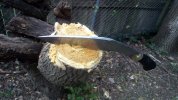- Joined
- Mar 27, 2008
- Messages
- 193
I have been a Kukuri fan since 1994 while in the Infantry, the functionality and effectiveness of the design won me over. Since that time I have had several types, CS LTC, ATC and Gurkia Kukuri, also the HI Ang Kola, M43, Tin Chirra, Dui Chirra and CAK. Primitive bush craft is something I enjoy and this style of blade really fits the bill and I have great respect for the Kamis that forge them.
Many in the knife community know about the cache of kukuris and other weapons found in Nepal back in 2003, a month or so ago I ordered a Bhojpure blade with no handle to see what a "real" military Nepalese kukuri was like. The plan was to put my own horn grip on it and try to make it a traditional as I could. Kukuri handle design is much more complex than it appears, done right and it is a dream to chop with...do it wrong and its blister city.
Here is how the blade arrived: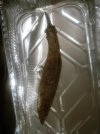 After a good cleanup and inspection I could find zero faults in the blade, it obviously had been issued at least once, if not more times since its manufacture (1930?). The edge had been sharpened often but well maintained, scratches were plentiful but nothing major, no cracks or even moderate pitting. I really wish it could talk, imagine the stories!
After a good cleanup and inspection I could find zero faults in the blade, it obviously had been issued at least once, if not more times since its manufacture (1930?). The edge had been sharpened often but well maintained, scratches were plentiful but nothing major, no cracks or even moderate pitting. I really wish it could talk, imagine the stories!
Next step was to gather handle supplies, horn, epoxy, flux and brass sheeting: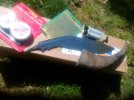
Some may worry about the traditional tang, we are use to full tang knives especially in the west. My thought was, it's their tool might as well stick with their design because if it didn't work the Nepalese probably would have changed it.
So after several hours of work and the realization that my brass and solder skills are very lacking, here was the result: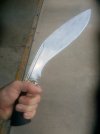
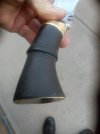
Next up was a solid sheath that would be safe and fit with my gear, 9oz vegtan and copper rivets with brass loops: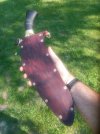
Many in the knife community know about the cache of kukuris and other weapons found in Nepal back in 2003, a month or so ago I ordered a Bhojpure blade with no handle to see what a "real" military Nepalese kukuri was like. The plan was to put my own horn grip on it and try to make it a traditional as I could. Kukuri handle design is much more complex than it appears, done right and it is a dream to chop with...do it wrong and its blister city.
Here is how the blade arrived:
 After a good cleanup and inspection I could find zero faults in the blade, it obviously had been issued at least once, if not more times since its manufacture (1930?). The edge had been sharpened often but well maintained, scratches were plentiful but nothing major, no cracks or even moderate pitting. I really wish it could talk, imagine the stories!
After a good cleanup and inspection I could find zero faults in the blade, it obviously had been issued at least once, if not more times since its manufacture (1930?). The edge had been sharpened often but well maintained, scratches were plentiful but nothing major, no cracks or even moderate pitting. I really wish it could talk, imagine the stories!Next step was to gather handle supplies, horn, epoxy, flux and brass sheeting:

Some may worry about the traditional tang, we are use to full tang knives especially in the west. My thought was, it's their tool might as well stick with their design because if it didn't work the Nepalese probably would have changed it.
So after several hours of work and the realization that my brass and solder skills are very lacking, here was the result:


Next up was a solid sheath that would be safe and fit with my gear, 9oz vegtan and copper rivets with brass loops:

Last edited:

